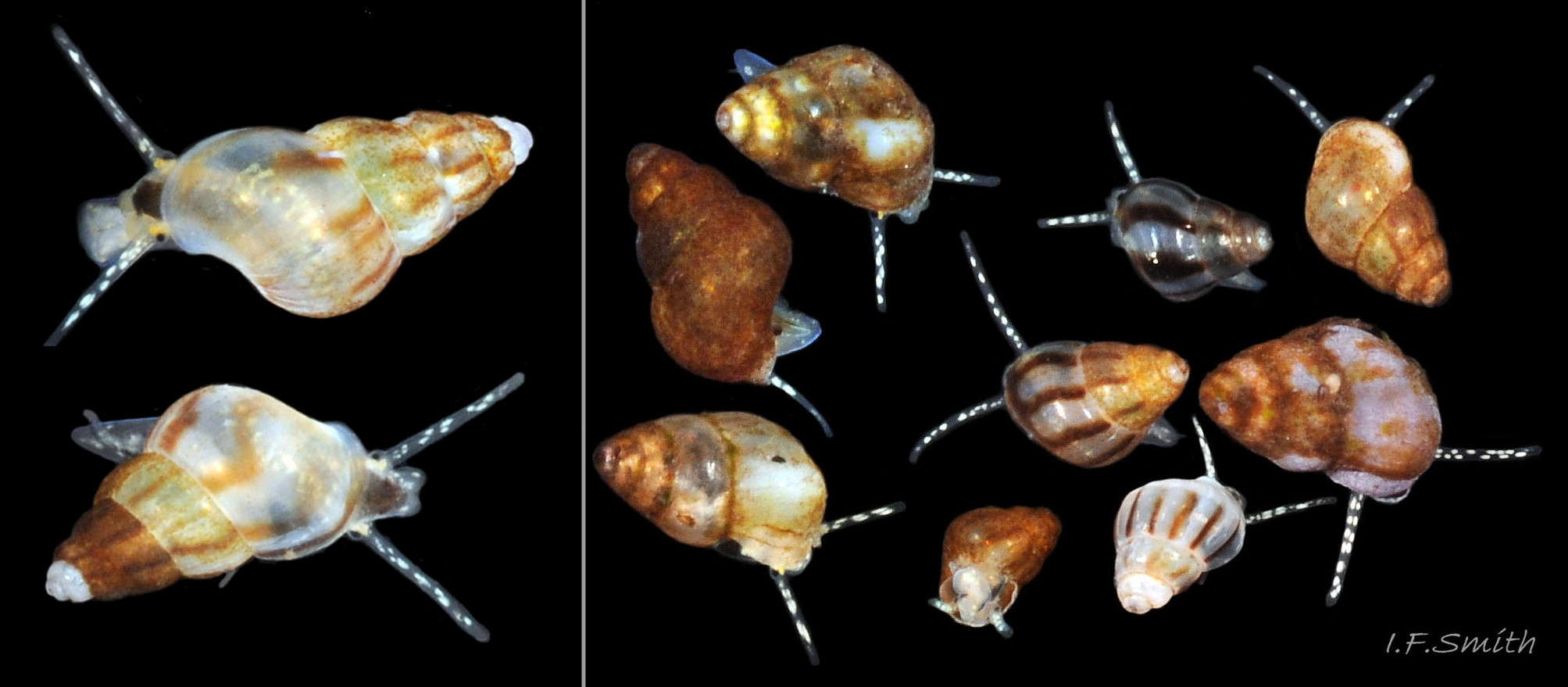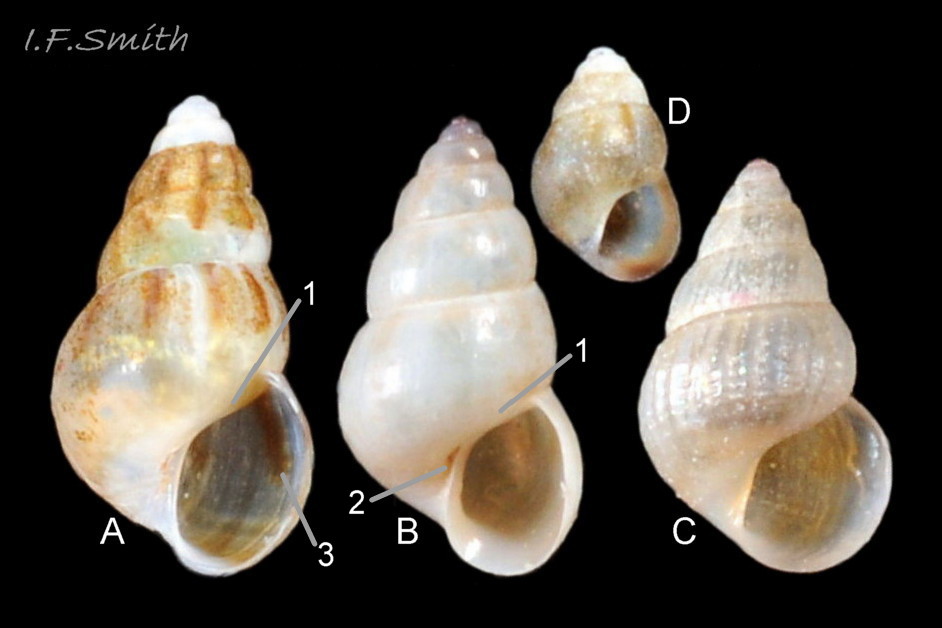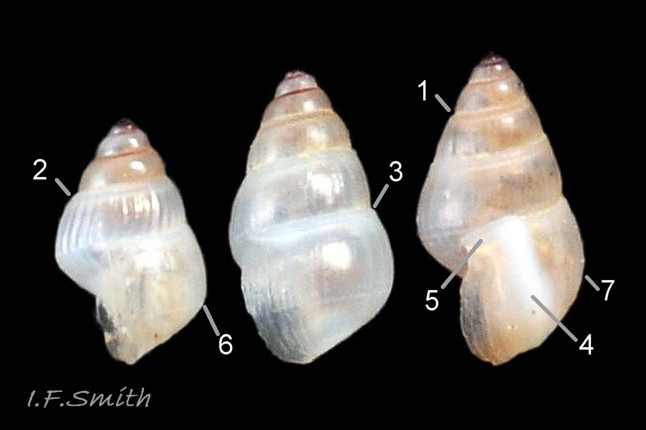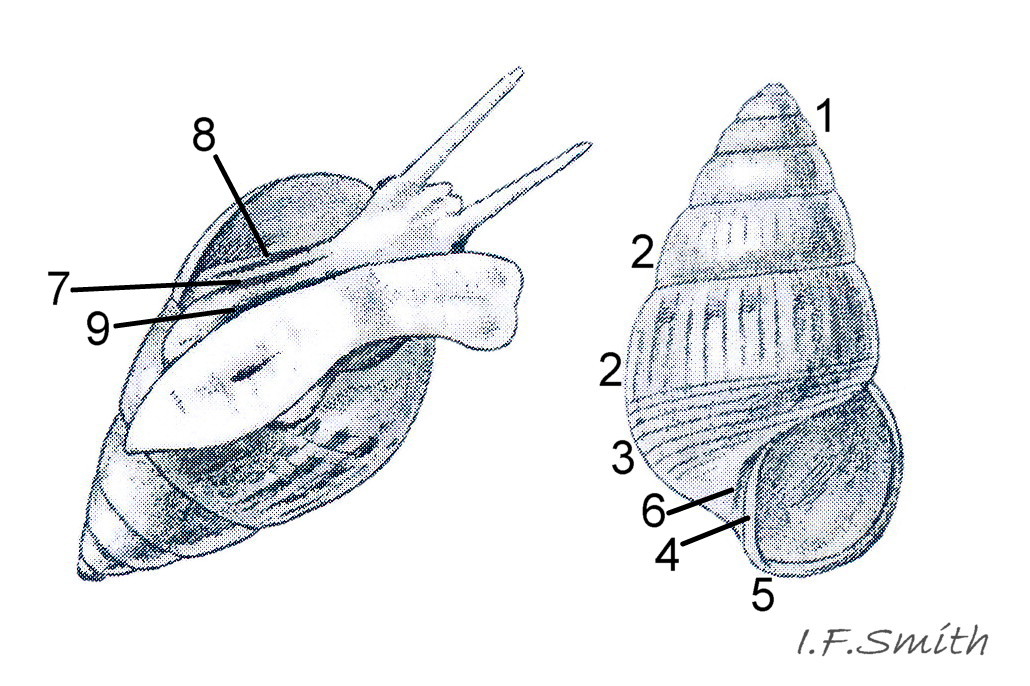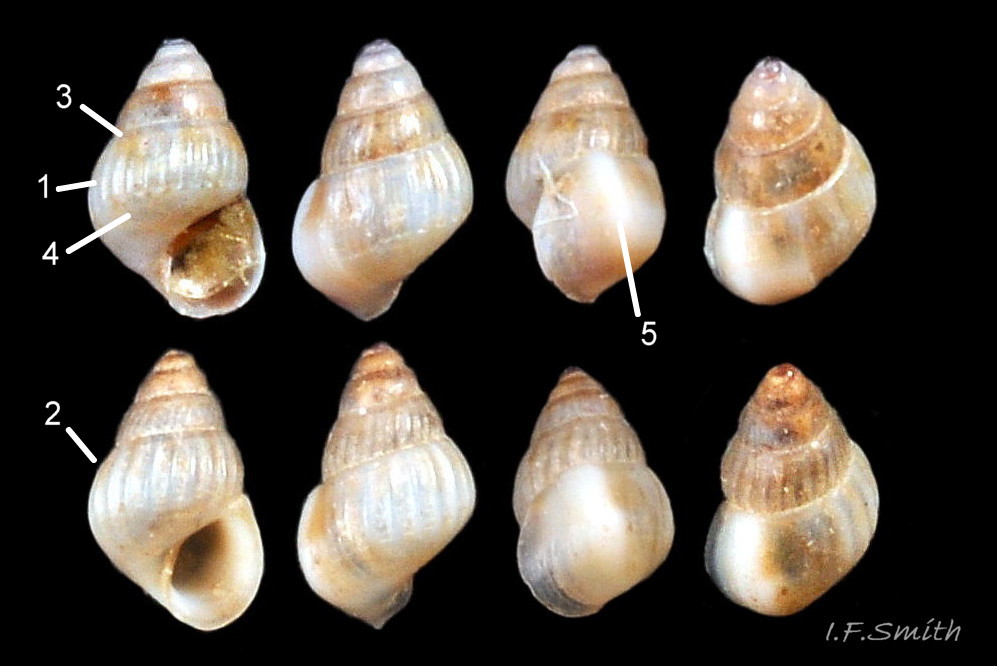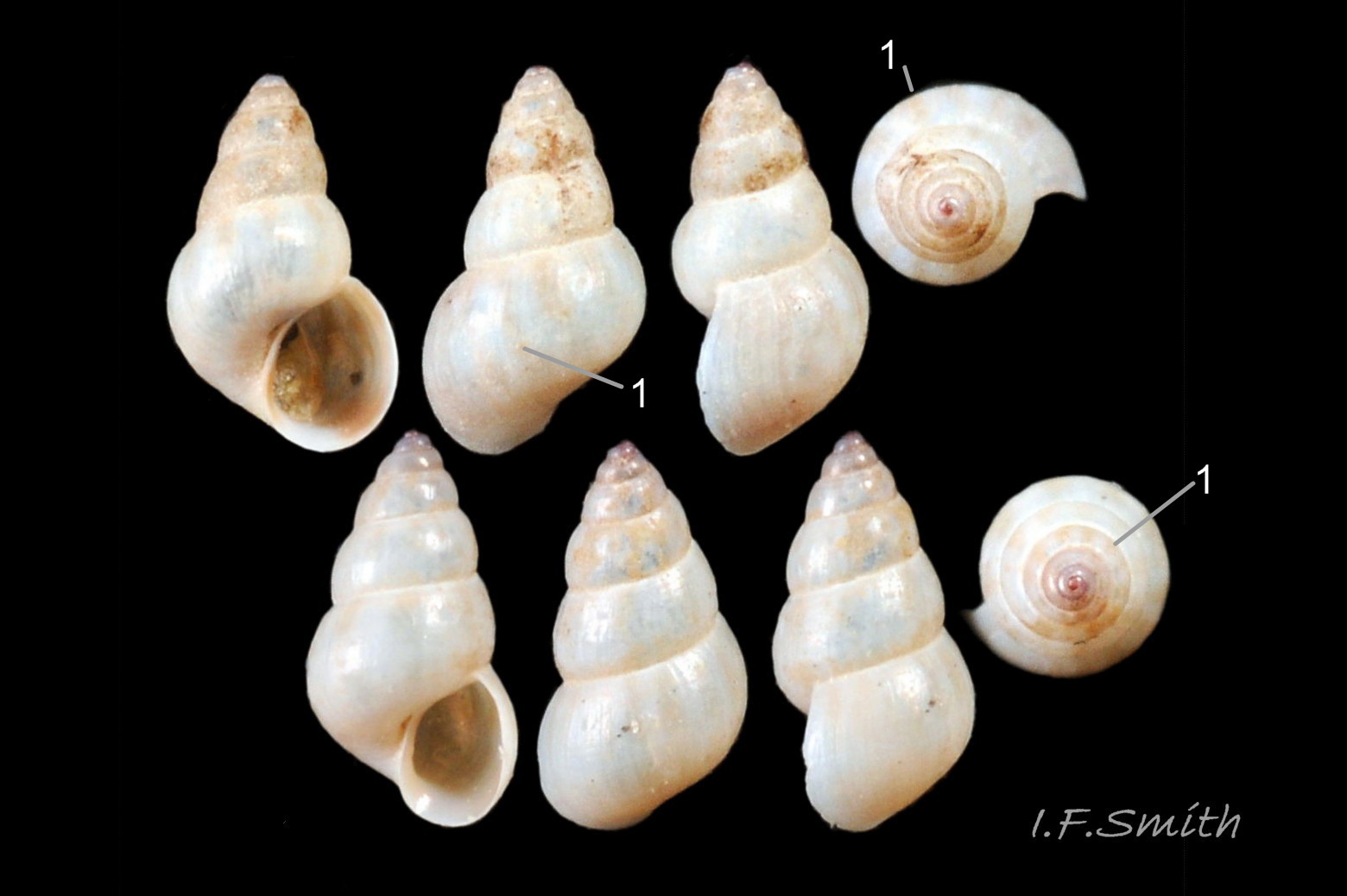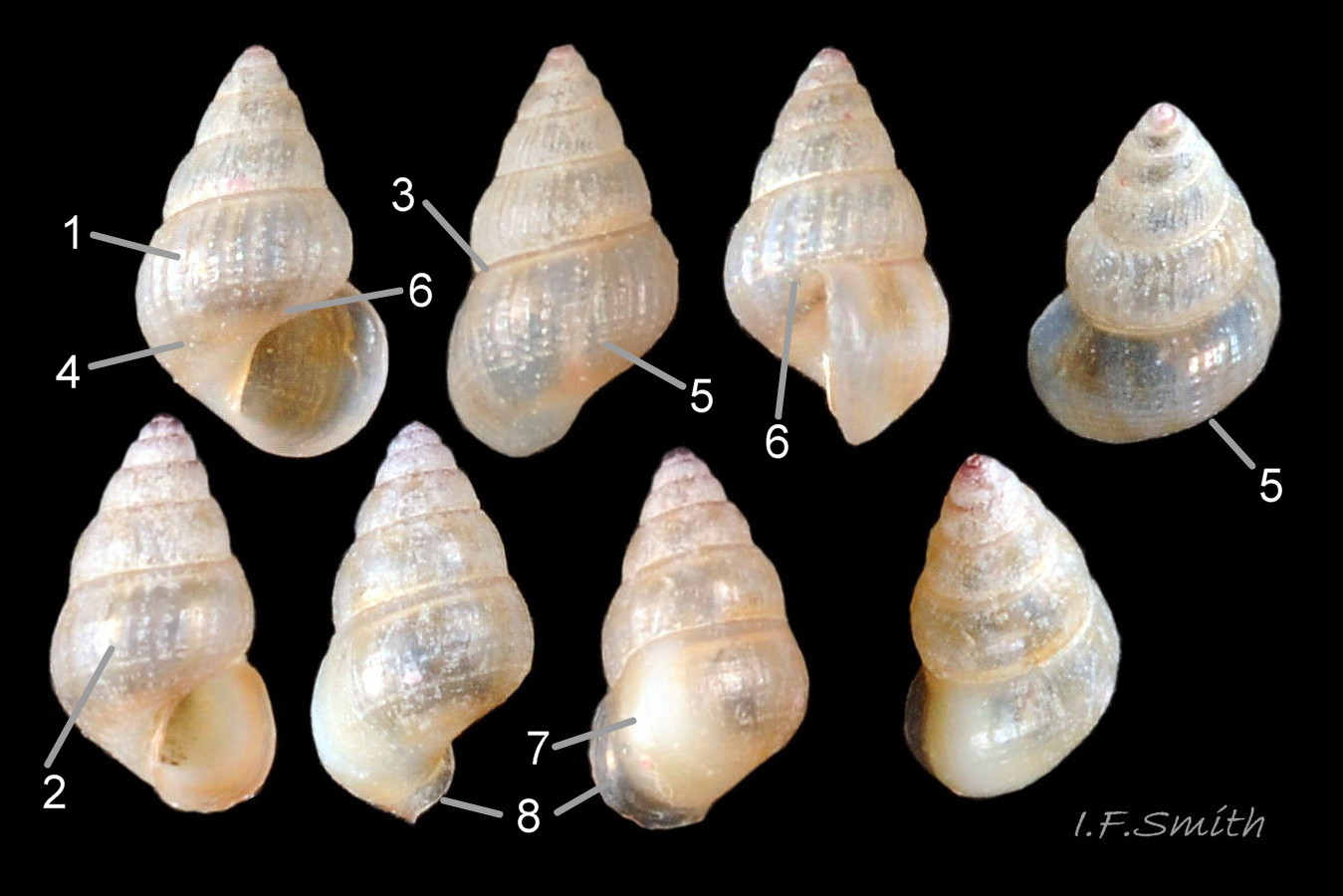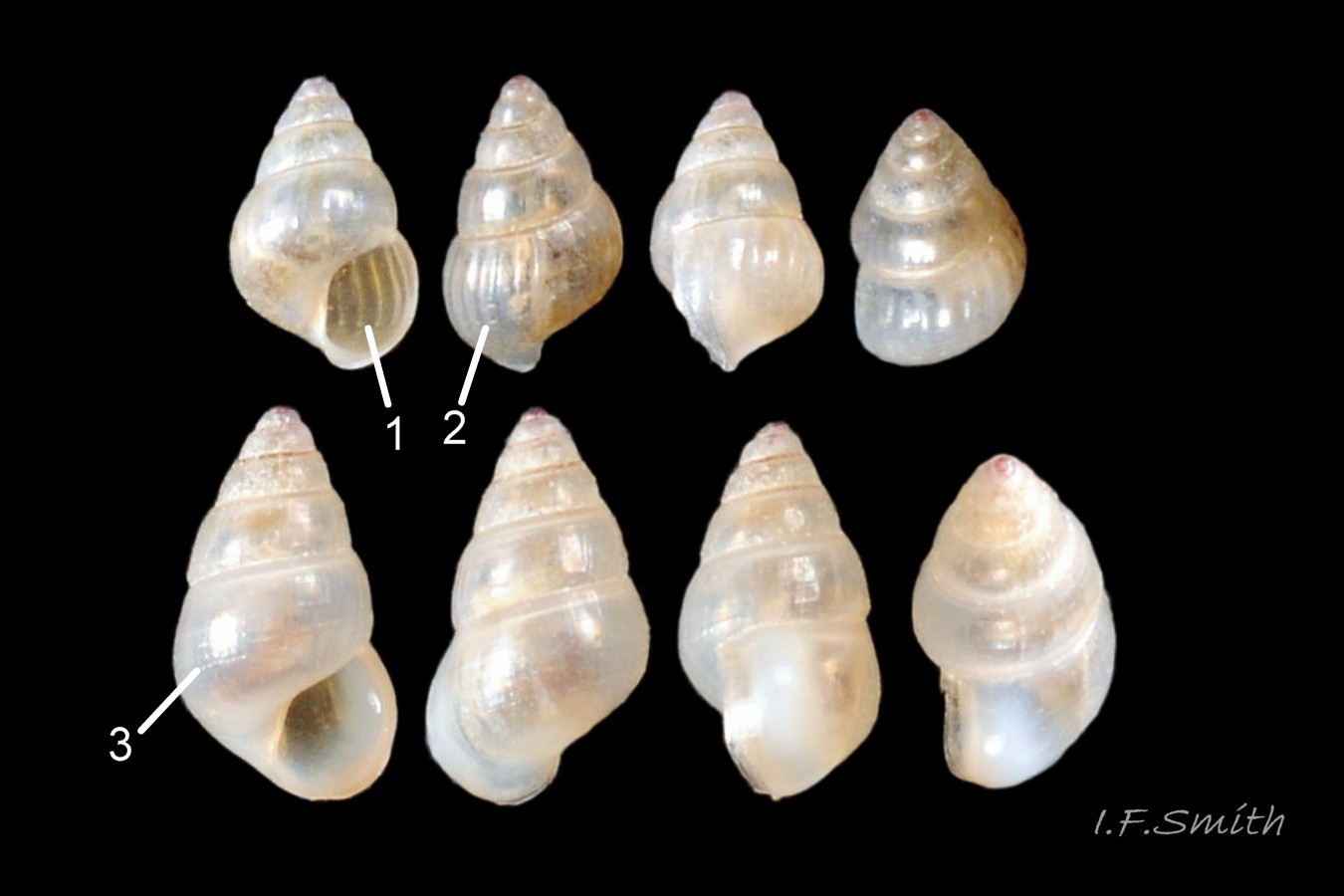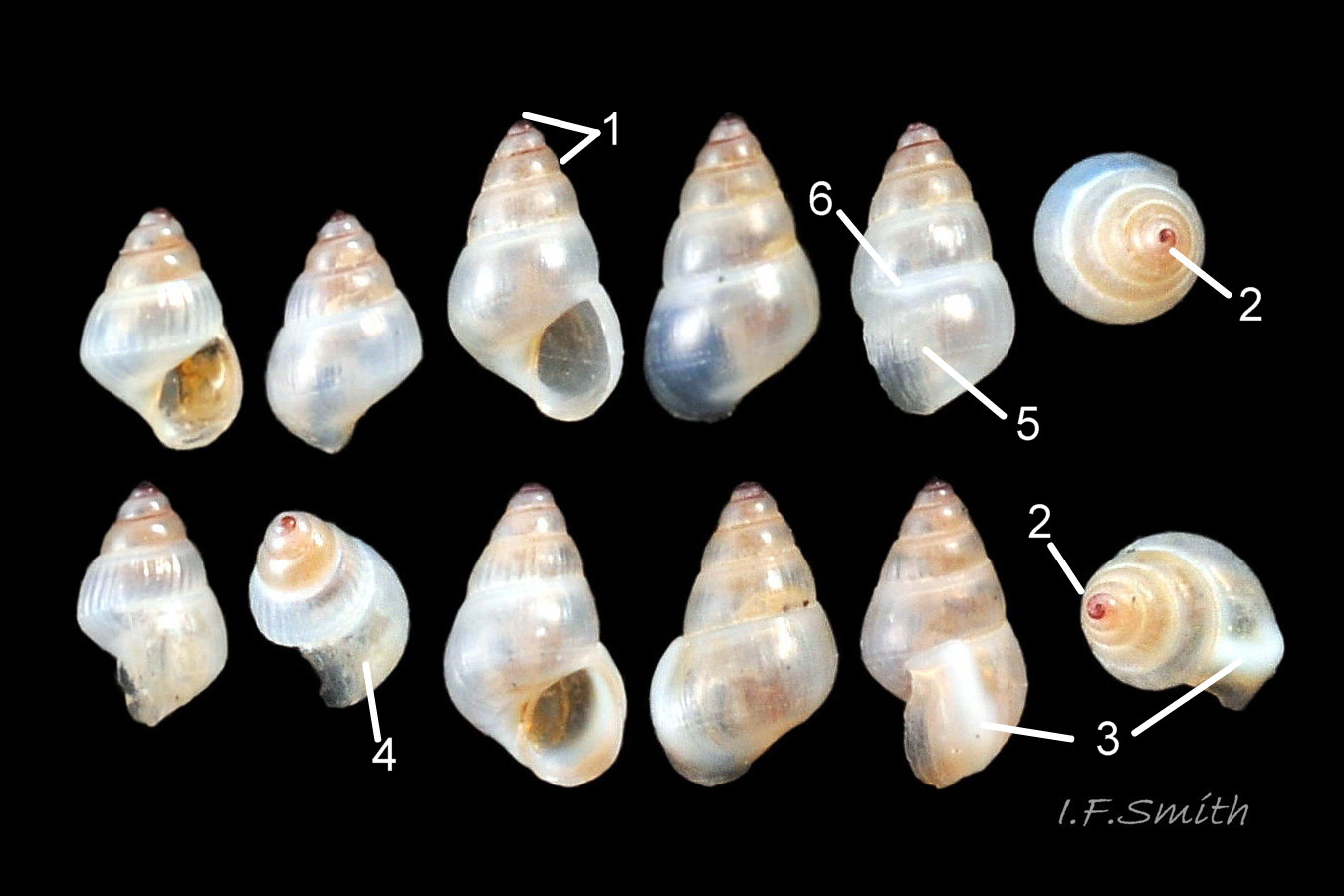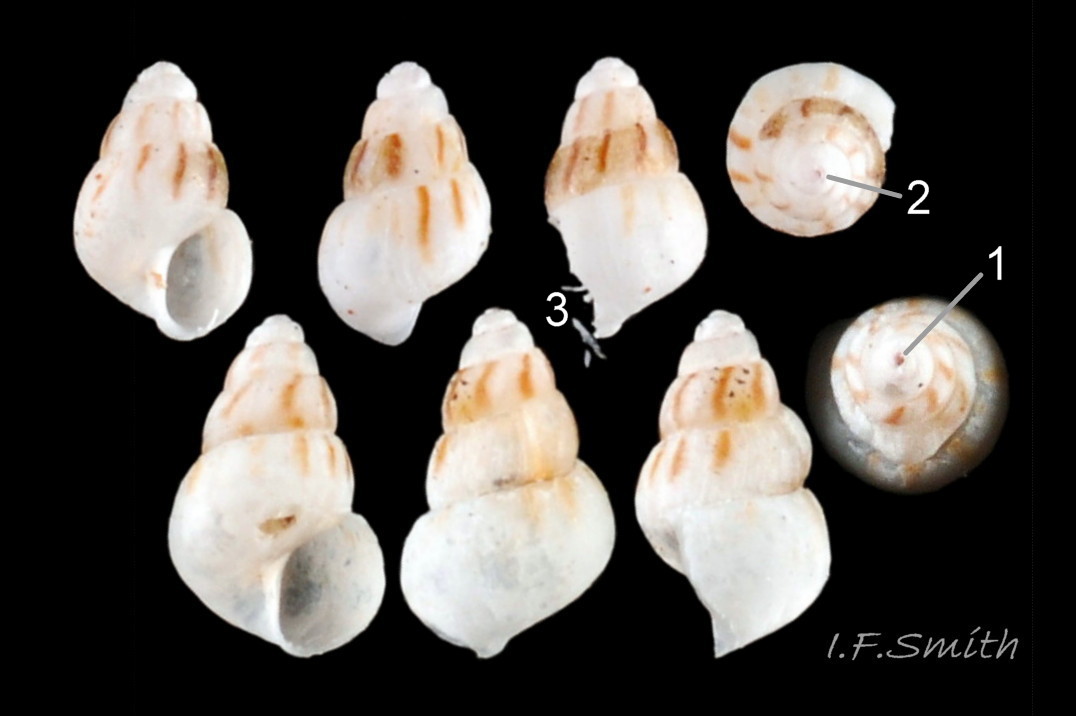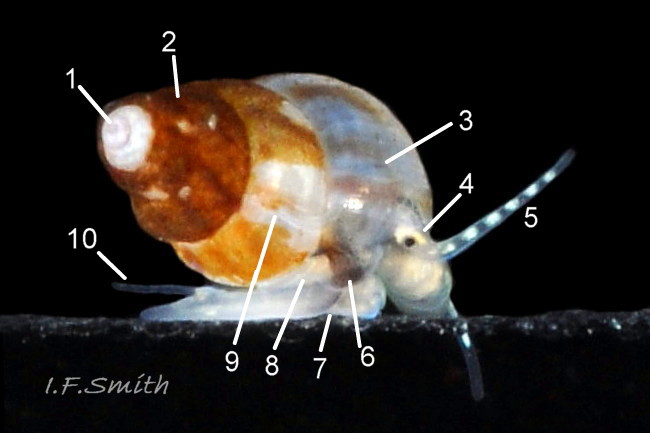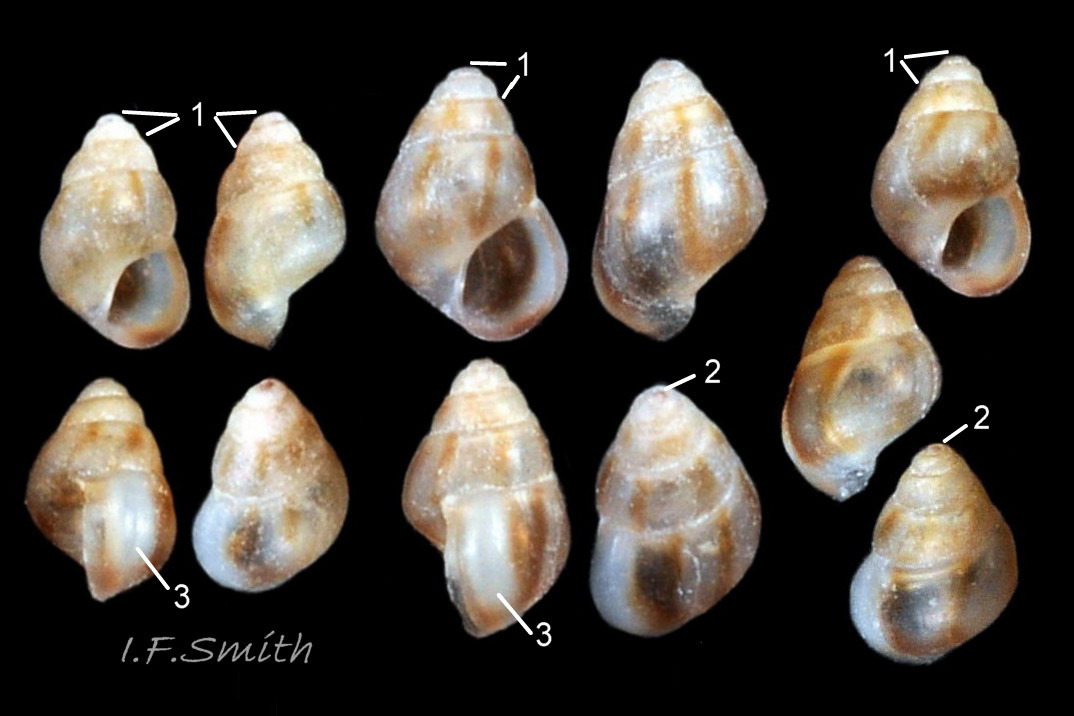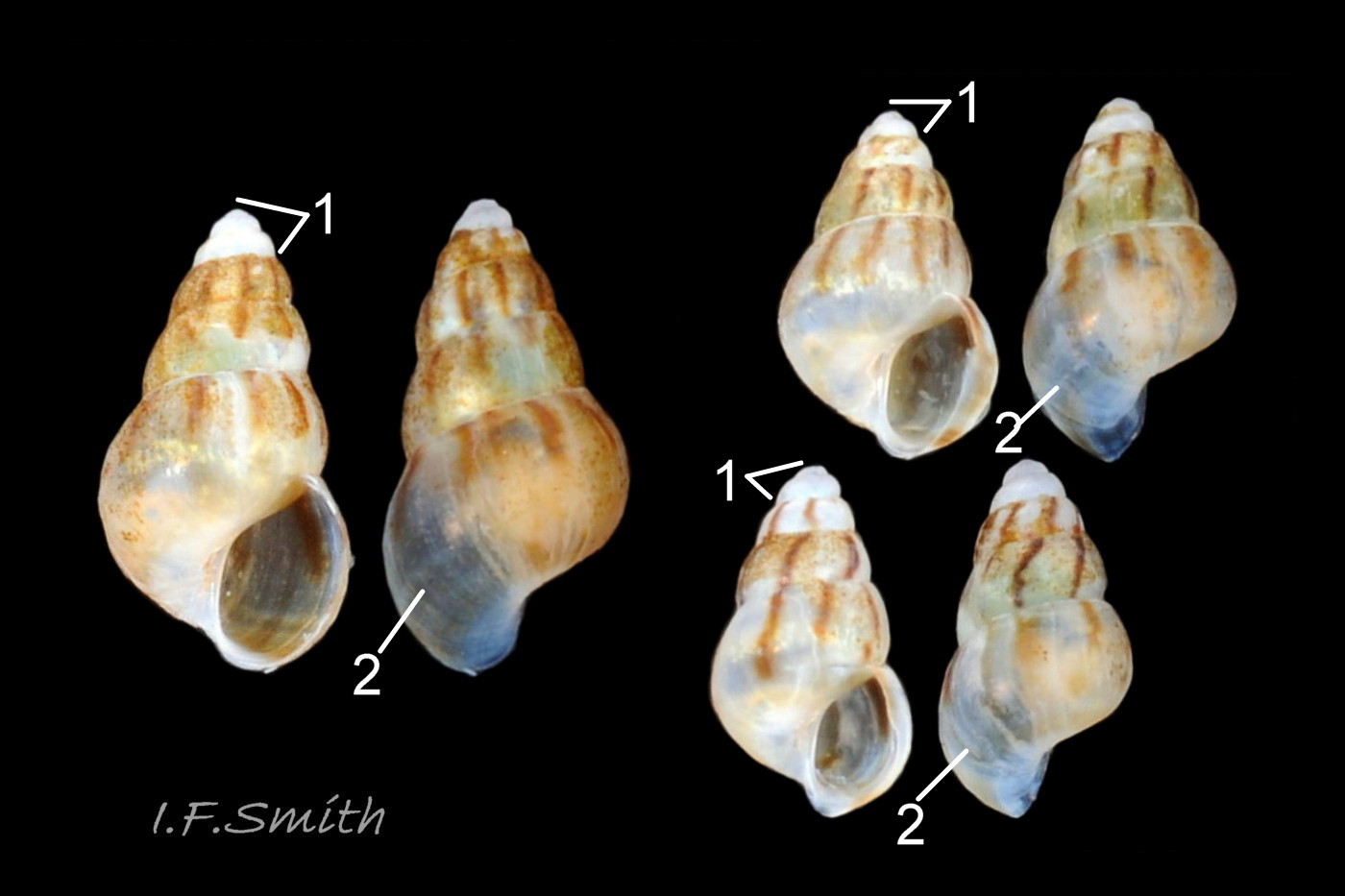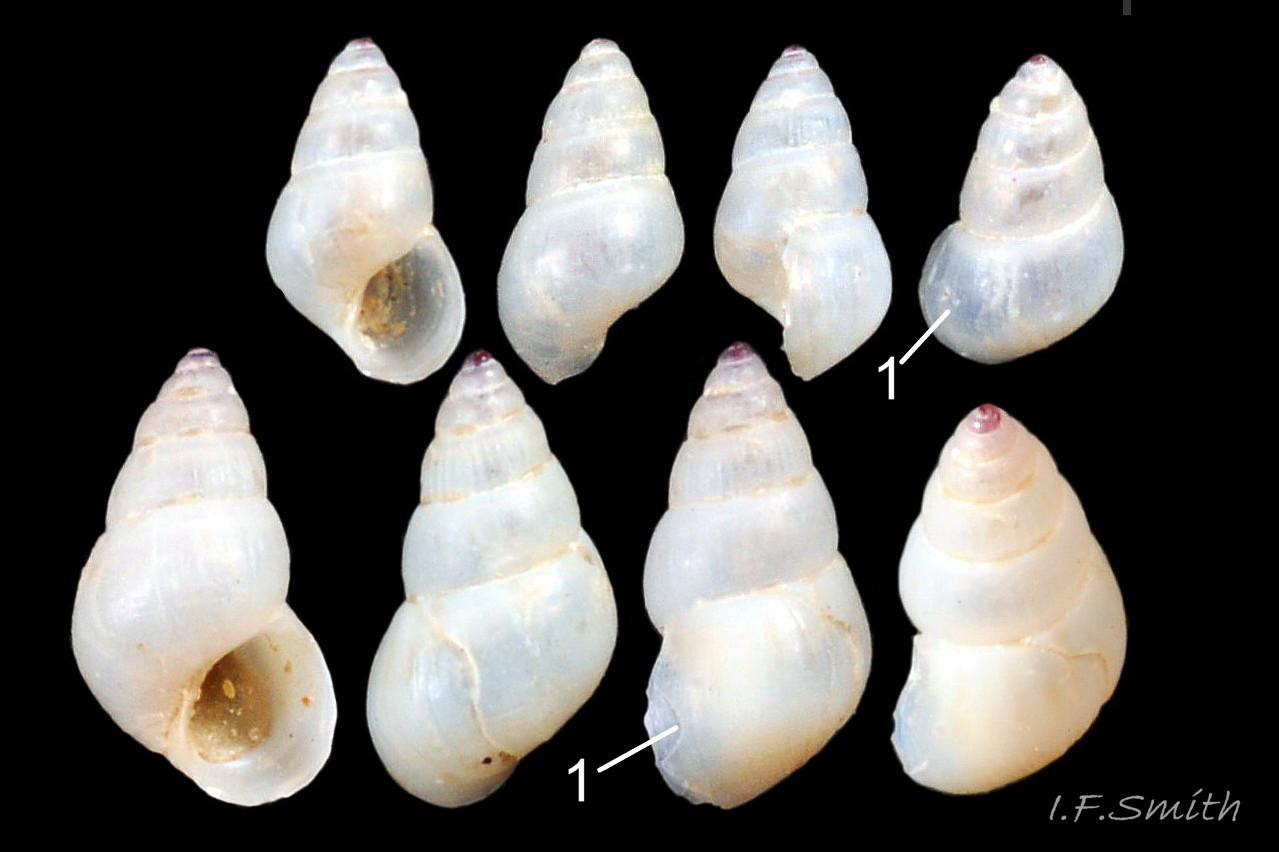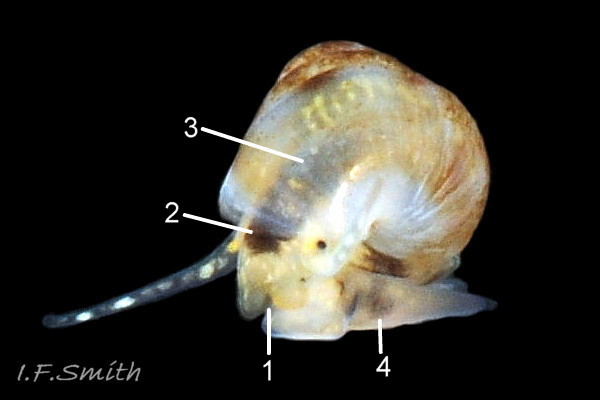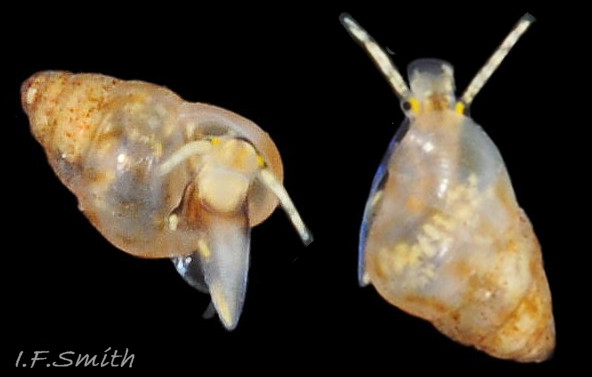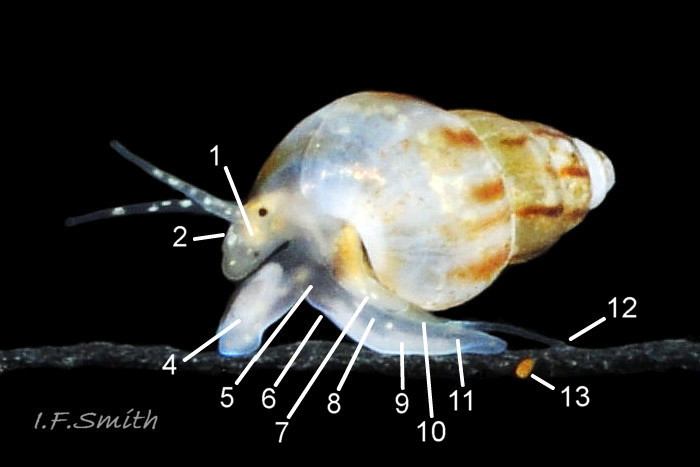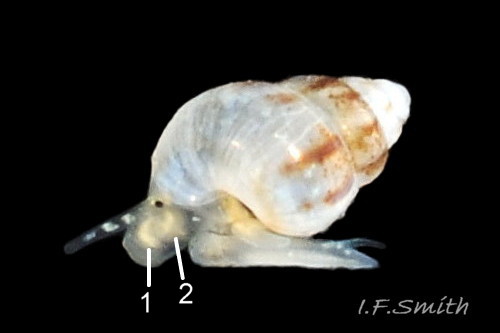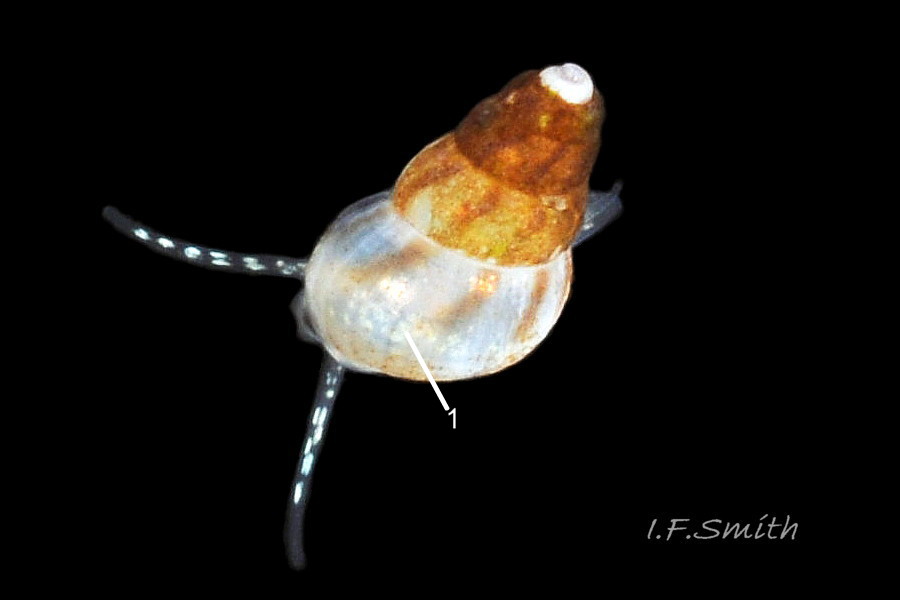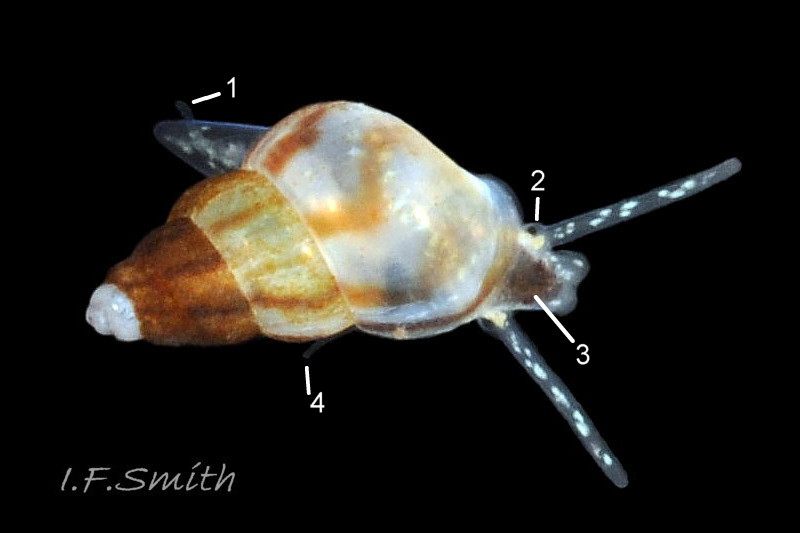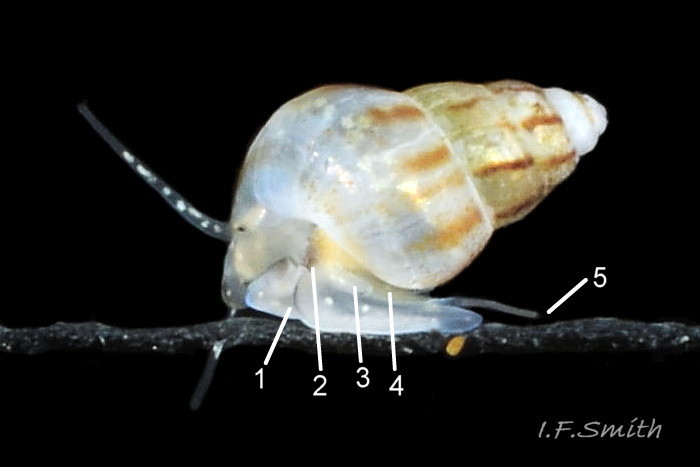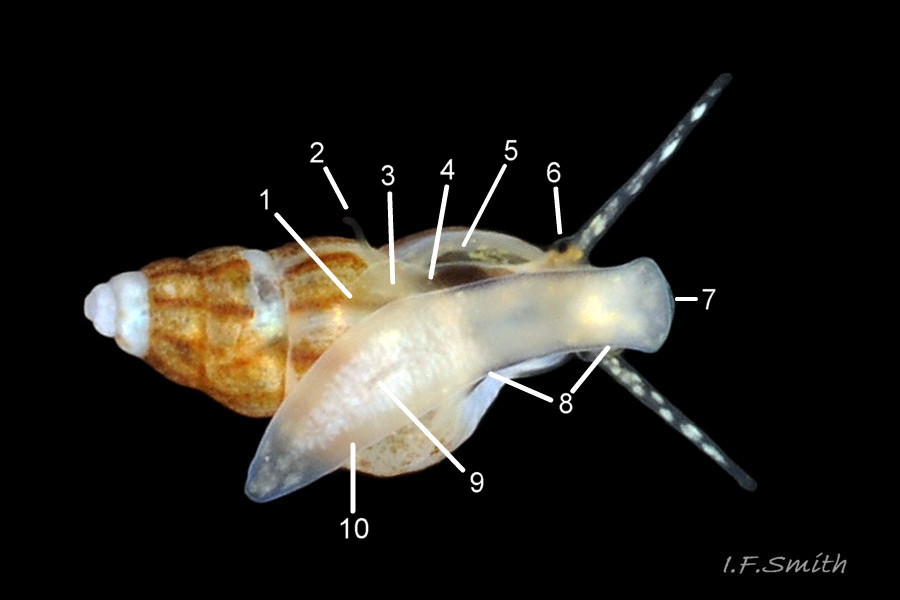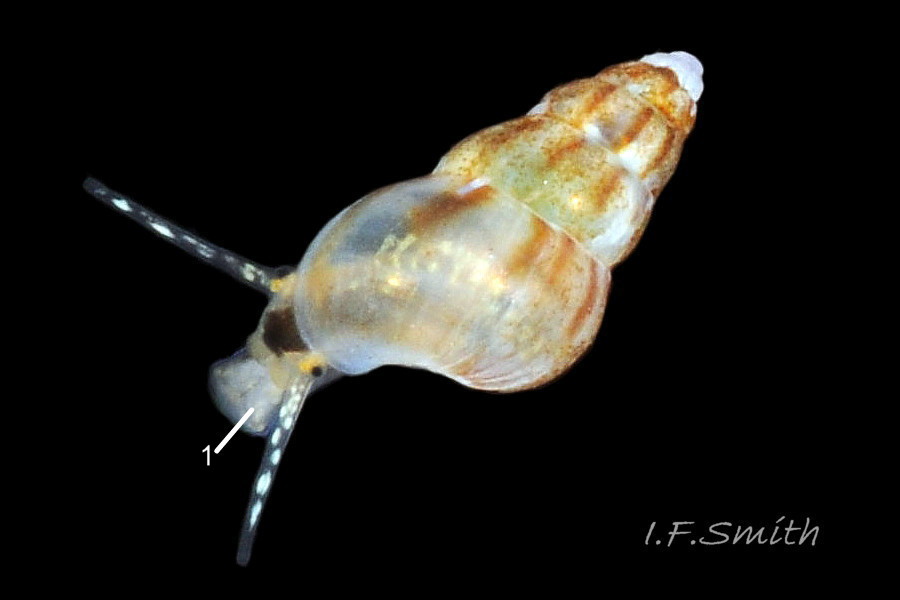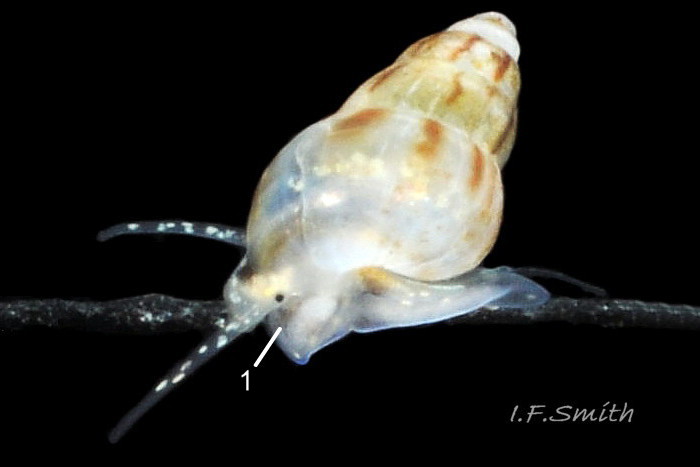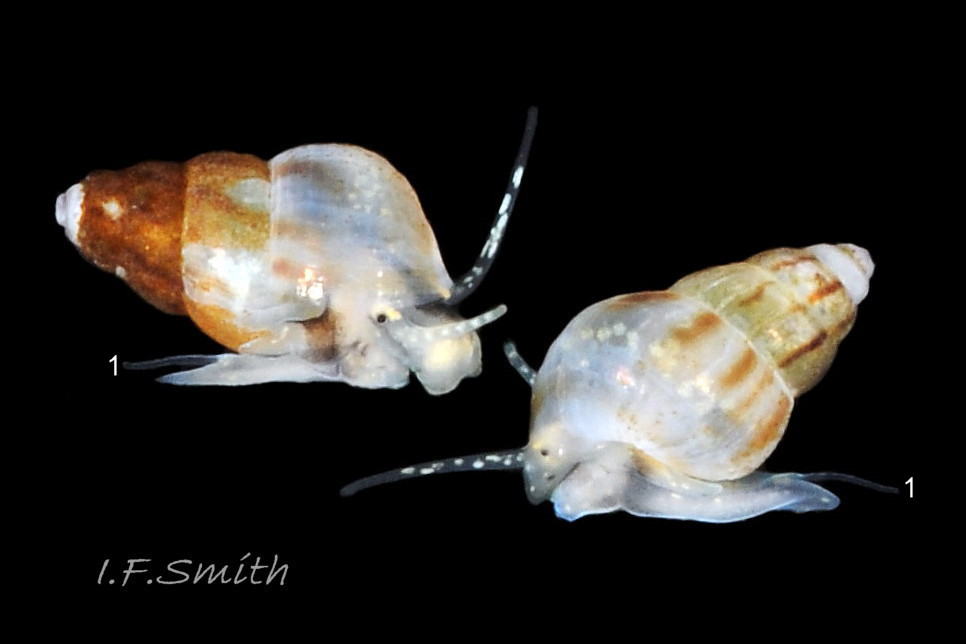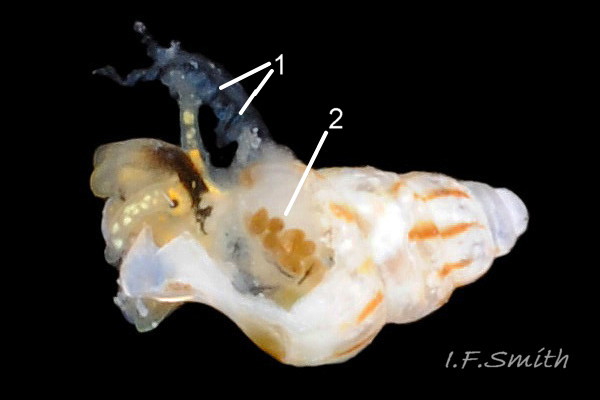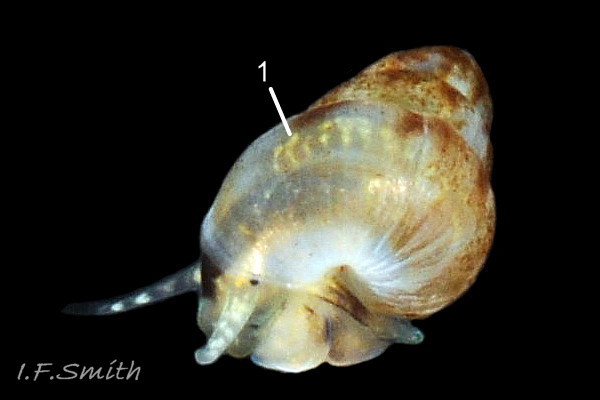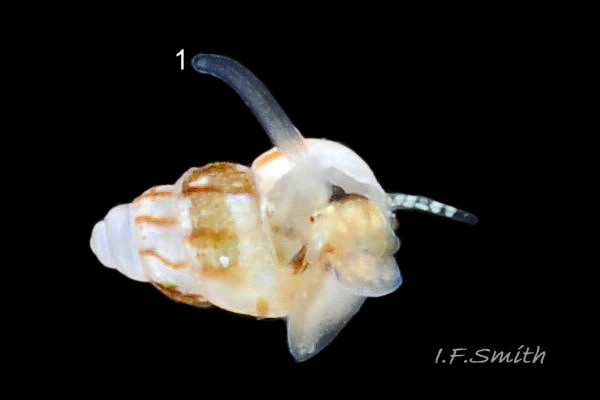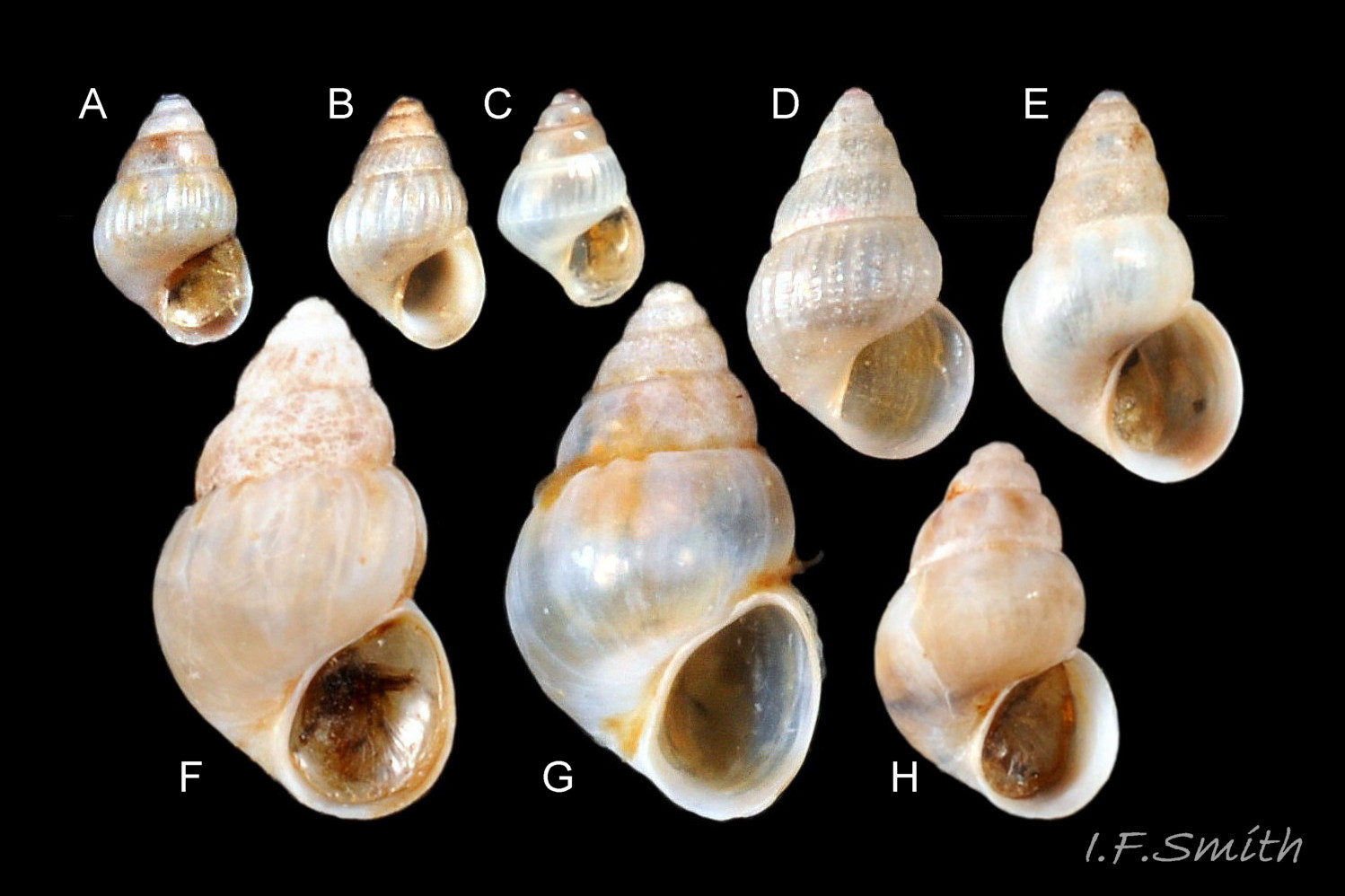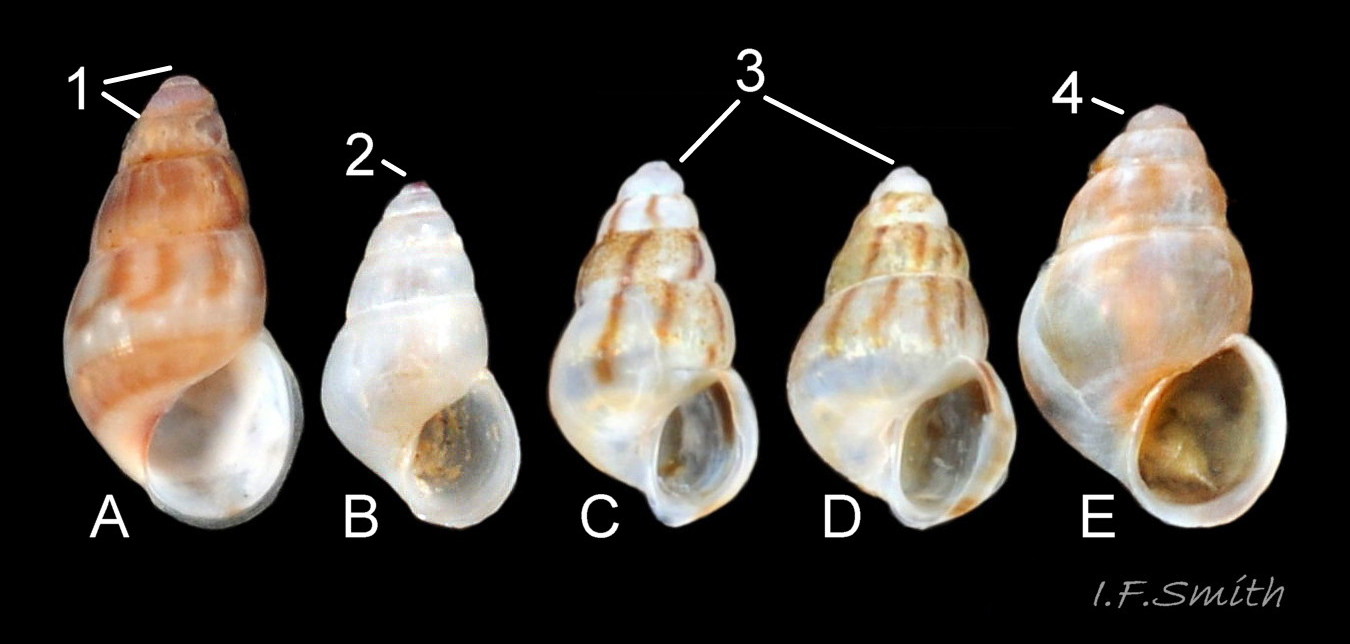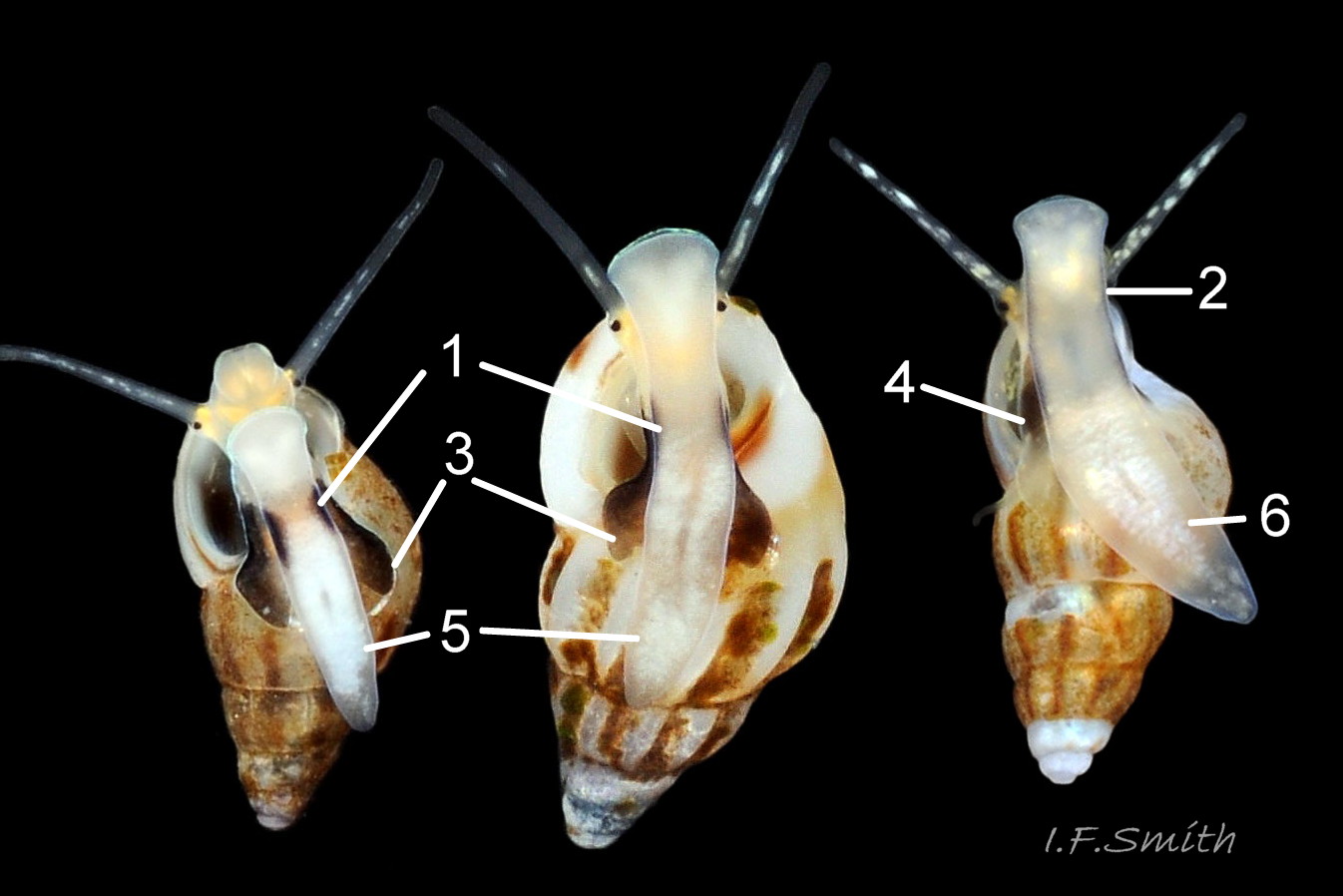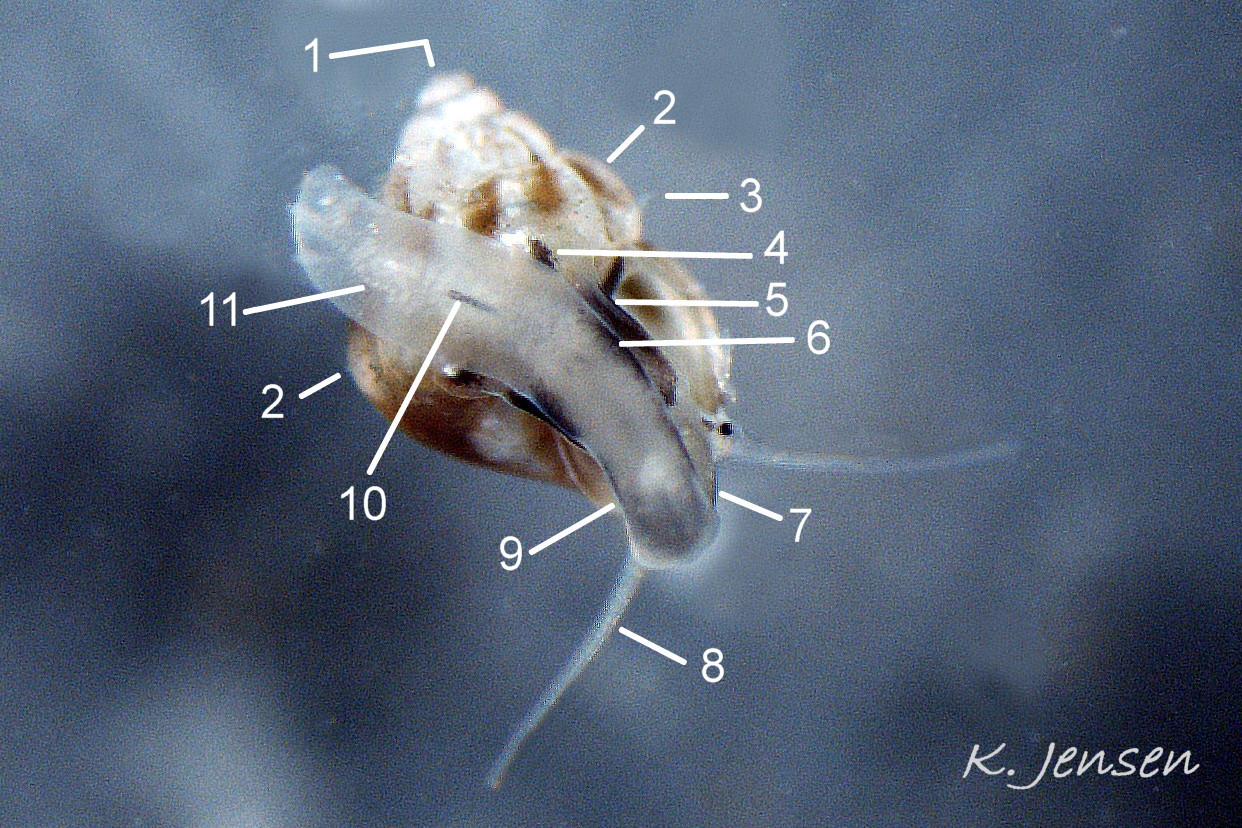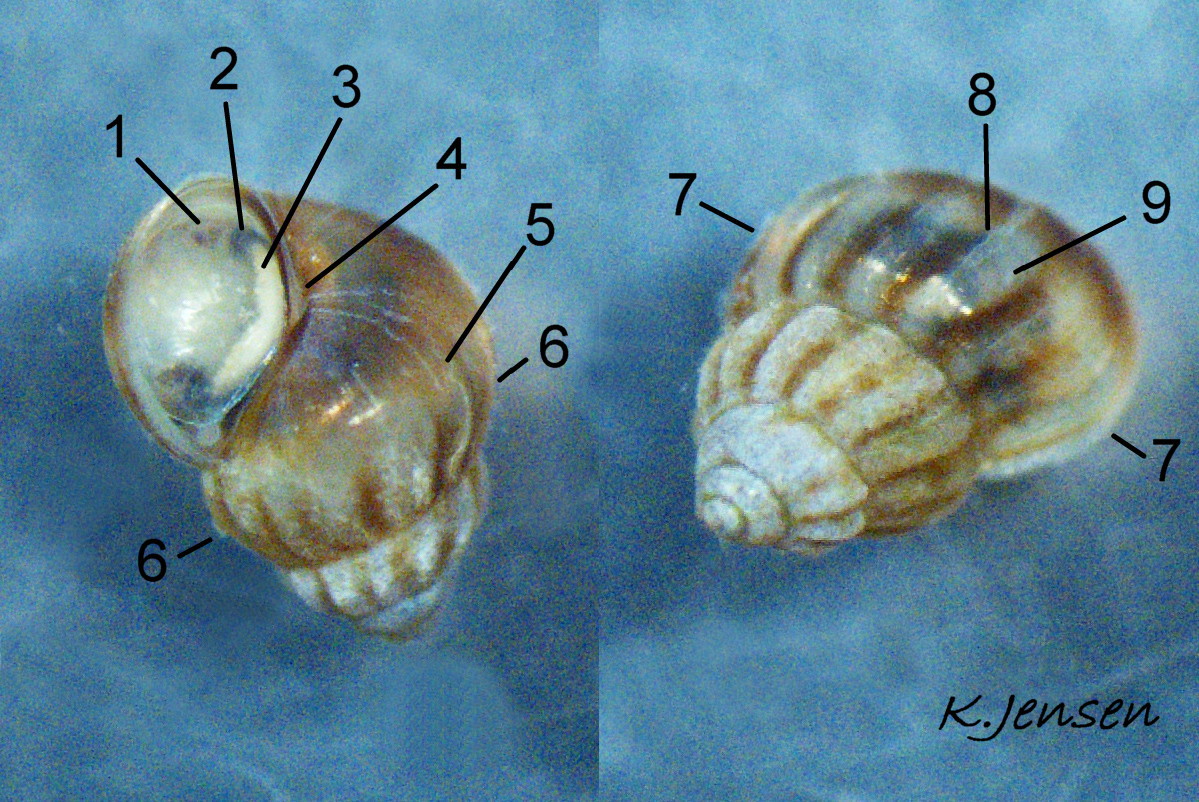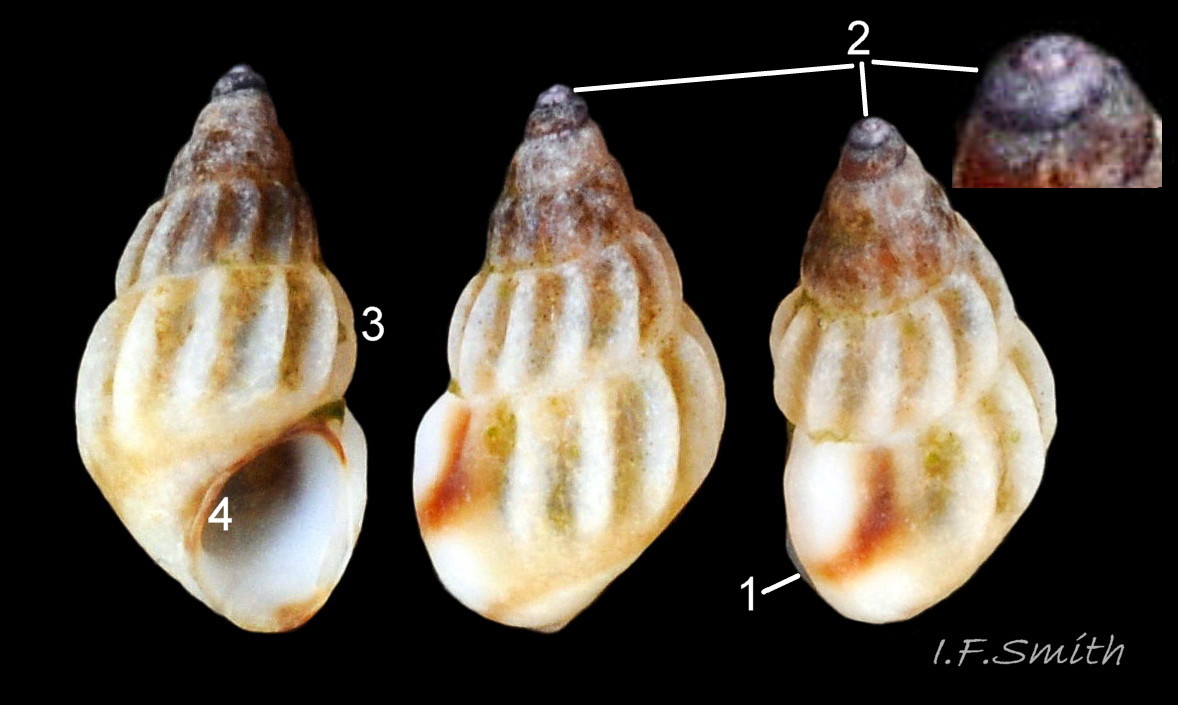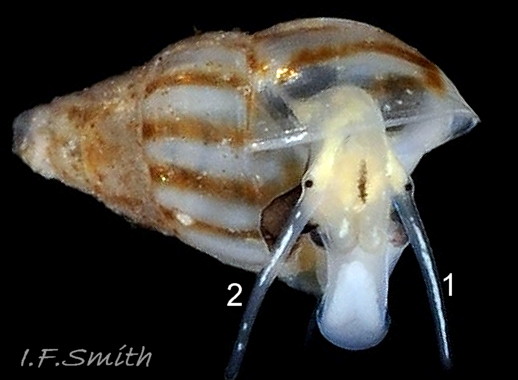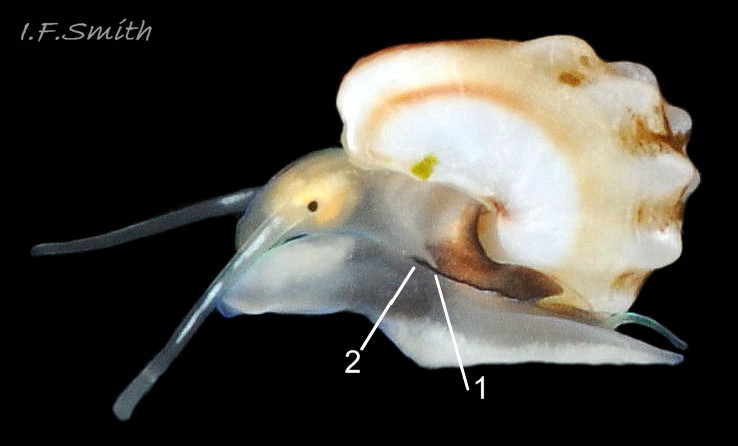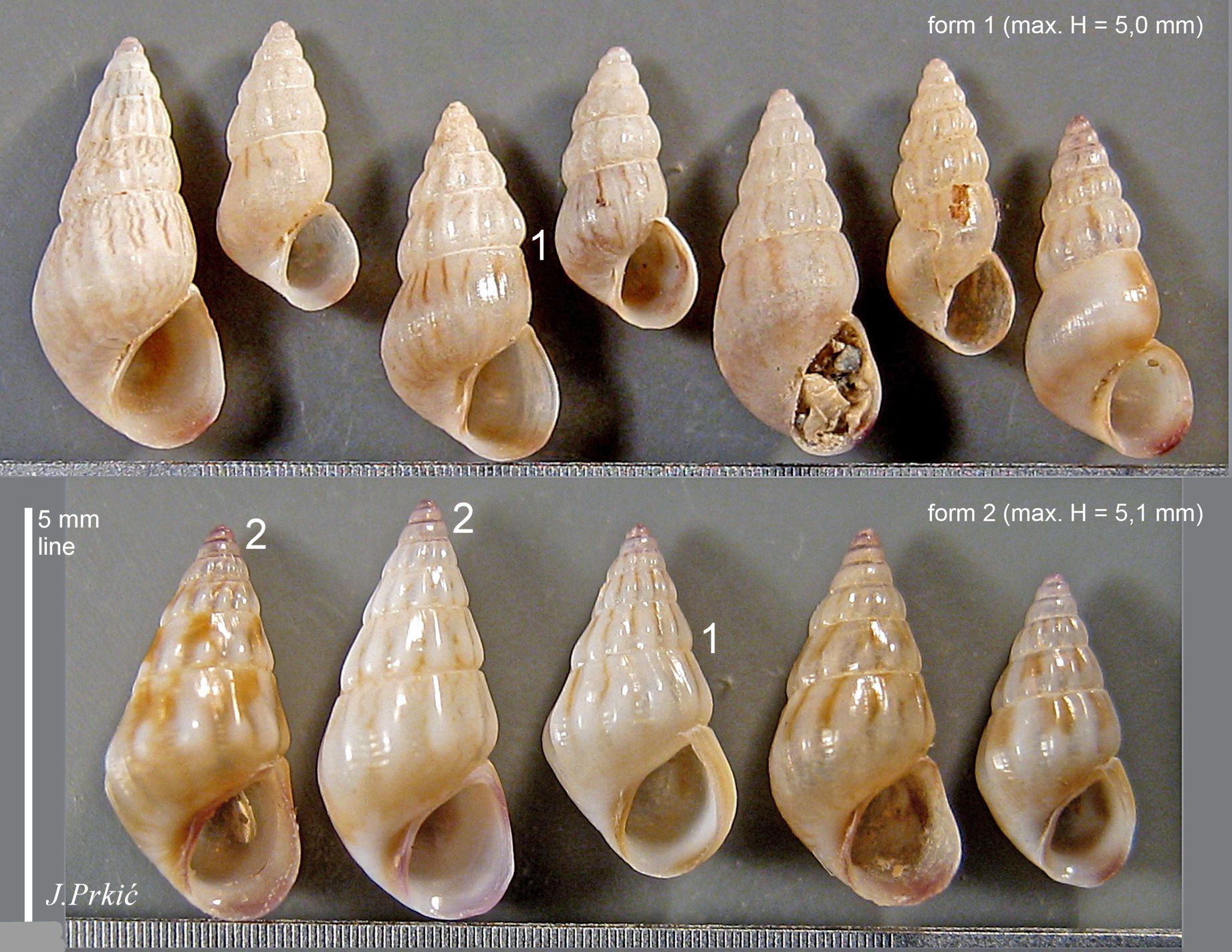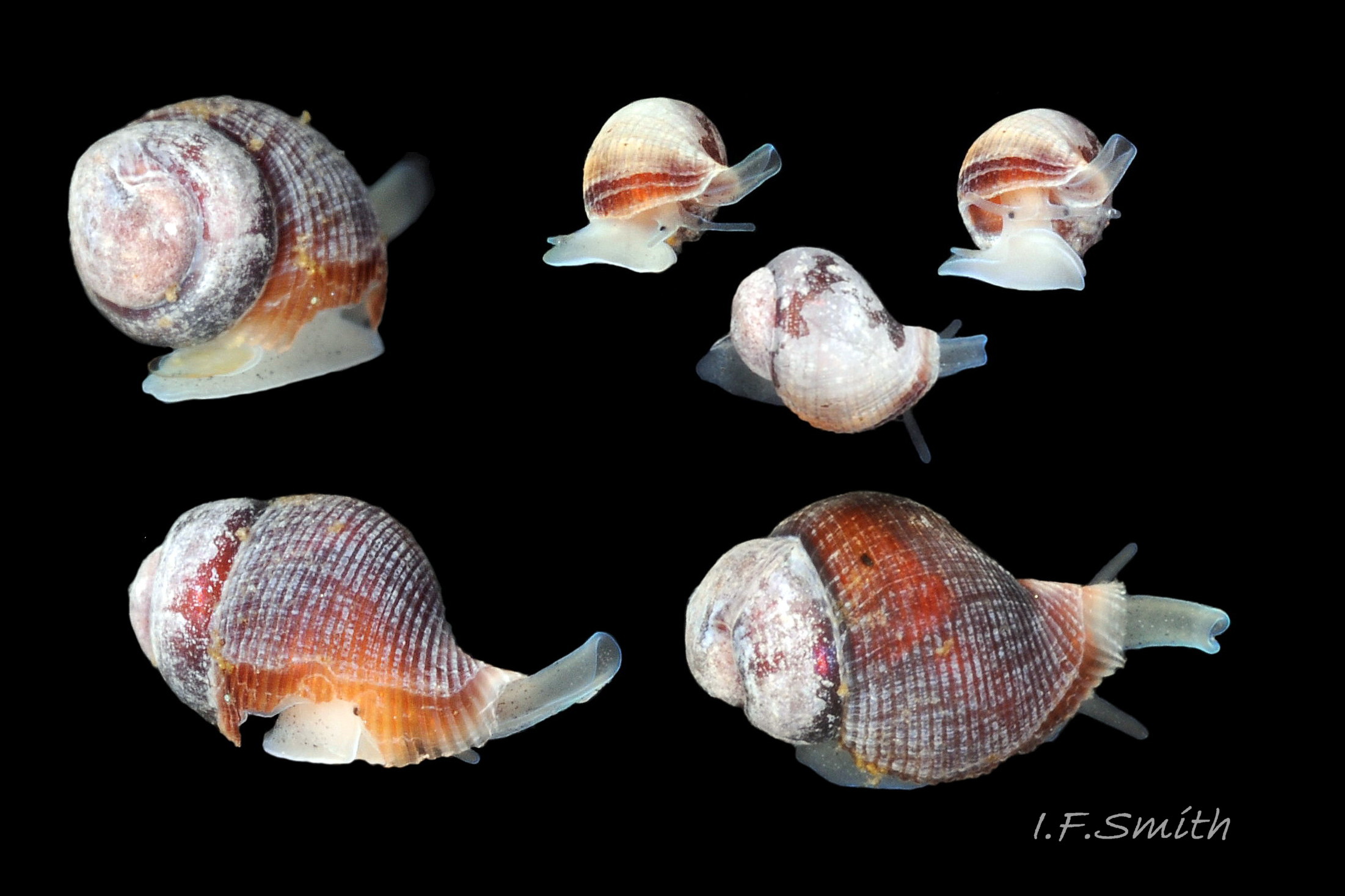Click image to enlarge with full caption. Main text below slider.
Pusillina inconspicua (Alder, 1844)
Synonyms: Rissoa inconspicua Alder, 1844; Turboella densa Nordsieck, 1972; Turboella diversa Nordsieck, 1972.
Current taxonomy: World Register of Marine Species (WoRMS) https://www.marinespecies.org/aphia.php?p=taxdetails&id=141334
Meaning of name:Pusillina = (Latin) very small. inconspicua = (Latin) inconspicuous.
Vernacular: tyndskallet tangsnegl (Danish); dwerg-drijfhoren (Dutch); mindre bandtångsnäcka (Swedish).
GLOSSARY below.
Preface
“- – a confusing ‘species’ and it is not easy to be convinced that not a species complex is involved here. – – samples [from all along Norwegian coast] document a high degree of local and geographical variability.” (Høisaeter, 2009)
“Rissoa inconspicua is perhaps one of the most variable of the genus, – – Alder’s original delineation of it combines characters that are not often found together in such high development; hence, despite its correctness, few specimens would be positively determined by comparison with it.” (Forbes & Hanley, 1853)
Shell description
P. inconspicua is a polymorphic species, varying greatly from site to site and within a single site both on a single date and seasonally 00 Pusillina inconspicua . More than one species may be involved. The maximum height of adults varies locally from 1.3 mm to 3.0 mm. The profile varies from squat (spire 23%, body whorl 77% of shell-height) to fairly tall (spire 40%, body whorl 60% of shell-height) 01 Pusillina inconspicua. Juveniles usually have a lower profile than adults 02 Pusillina inconspicua . The shells are thin and very fragile. The whorls are clearly defined by the suture, and distinctly convex without angulation except for narrow sloping bevel below the suture 02 Pusillina inconspicua. The bevel is conspicuous on thin translucent specimens as it is thicker than the rest of the shell. Sometimes the bevel is broader where it acts as extension of a labial varix. The periphery of the body whorl is well rounded on adults and juveniles.
The sculpture varies; Alder (1844) stated, “upper whorls smooth; the penultimate [adapical] half of the last whorls generally marked with numerous very delicate and faint ribs or plicae [costae], about thirty in number, the bases of which are crossed on the body whorl by a few faint spiral striae, giving that part a reticulated appearance. The whole of the markings are very delicate and sometimes entirely wanting.” Only a small minority distinctly display all features illustrated 03 Pusillina inconspicua and described by Alder. For example there was only one costate specimen among 359 from three Norwegian sites (Høisaeter, 2009). Graham (1988) stated “nearly always numerous fine costae”, but a very small minority of hundreds of shells examined by IFS had them. A great number of merging forms result from kaleidoscopic combinations of Alder’s shell-features, but a single form often predominates at individual sites. But Warén (1996) considered it “unusually constant in its shell morphology, from northern Norway to the Mediterranean”.
Sculpture variations include distinct, fine, numerous costae (9-15 on apertural view of body whorl) 04 Pusillina inconspicua; no costae 05 Pusillina inconspicua; square-reticulation created by spiral striae crossing distinct costae 06 Pusillina inconspicua; and weak reticulation created by spiral striae crossing barely visible costae 07 Pusillina inconspicua. Costae, when present, do not cross the sub-sutural bevel or basal half of the body whorl 02 Pusillina inconspicua, 04 Pusillina inconspicua & 06 Pusillina inconspicua.
The embryonic and larval protoconch forms the three apical whorls. It always lacks costae, is usually the same ground colour as the rest of the shell and has a tiny purple, occasionally yellow, apical spot confined to the single embryonic whorl, not extending onto the two larval whorls of the protoconch. The apical spot may be distinct 08 Pusillina inconspicua, faint, very minute 09 Pusillina inconspicua or absent 10 Pusillina inconspicua . On shells bearing brown markings the white protoconch contrasts distinctly with the rest of the shell 11 Pusillina inconspicua & 12 Pusillina inconspicua.
The ground colour of the shell is whitish, sometimes with patches of light horn-colour 04 Pusillina inconspicua; more 08 Pusillina inconspicua or less 05 Pusillina inconspicua translucent; with axial streaks of brown varying from strongly 11 Pusillina inconspicua to very weakly 05 Pusillina inconspicua developed or, very often, missing 13 Pusillina inconspicua. Some live specimens have a layer of layer which comes off if a shell is rotted out in water; compare 09 Pusillina inconspicua with same shell before rotting 10 Pusillina inconspicua . Many mature adults have a broad white labial varix set back from outer lip of the aperture. Usually it is not very thick and is most discernible on shells which are brown-streaked 11 Pusillina inconspicua or thin and almost transparent 08 Pusillina inconspicua. The varix is missing from juveniles and from adults at some sites 10 Pusillina inconspicua & 13 Pusillina inconspicua.
The aperture height is 35% to 50% of shell height. The shape varies but many are “ straight at the pillar, [columellar lip] and slightly angulated at the base beneath it” Alder (1844) 01 Pusillina inconspicua & 03 Pusillina inconspicua. The parietal lip is a thin glaze on the body whorl and the peristome is not distinctly continuous there 01 Pusillina inconspicua. The aperture rim is usually white and occasionally has slight brown marks. The curved outer (palatal) lip has a thin edge even on mature specimens 06 Pusillina inconspicua as any varix is rarely thick and usually set back from the edge. The columellar lip is slightly reflected, usually leaving an umbilical groove between it and body whorl 01 Pusillina inconspicua & 03 Pusillina inconspicua. Internally, the aperture is translucent showing any brown exterior marks 01 Pusillina inconspicua.
Body description
Caveat: most live images in this account are from a single site in North Wales. It is possible that soft-parts at other sites may vary. For example, Høisaeter (2009) found the dark head pattern at one site to be much faded at two other sites. The flesh is translucent whitish with some opaque blotches of yellow or white. The snout is deeply bifid 14 Pusillina inconspicua and often has a broad medial blackish or brown-umber band which extends onto the head and body 14 Pusillina inconspicua . The band was found on all live specimens examined/photographed from the main Welsh site. It was more faded on a specimen from another site, but this may be because it was a juvenile 15 Pusillina inconspicua. Often, there are a few opaque white or yellow marks on the snout 16 Pusillina inconspicua. When the pale-yellow salivary glands and buccal mass are retracted, the snout is translucent whitish and the head is yellow 16 Pusillina inconspicua . When glands and buccal mass are pushed forwards, the snout is yellow and the head is translucent whitish 17 Pusillina inconspicua .
The cephalic tentacles are translucent white with two parallel irregular rows of substantial, opaque-white, hyphen-like marks in each tentacle 18 Pusillina inconspicua ; in lateral view one row may conceal the other 10 Pusillina inconspicua. A slight swelling at the base of the tentacle 19 Pusillina inconspicua bears a large black eye with a dorsally-enclosing, semi-circular, opaque-yellow mark 10 Pusillina inconspicua.
The dorsal surface of the foot is translucent whitish with a broad, dark, transverse band anterior of the mid-point 16 Pusillina inconspicua . There are two dark-purple or black longitudinal lines on each side; one dorso-lateral and one on the periphery of the foot (Alder, 1844) 03 Pusillina inconspicua; they are often faint and partial 20 Pusillina inconspicua & 16 Pusillina inconspicua or imperceptible at some sites. The peripheral line often extends forwards well beyond the transverse band on the dorsal surface 21 Pusillina inconspicua . The anterior quarter of the foot has a whitish, heart-shaped, anterior pedal mucous gland 22 Pusillina inconspicua ; sometimes with blackish/grey surface blotch 23 Pusillina inconspicua & 16 Pusillina inconspicua . The posterior half of the foot has an opaque-white posterior pedal gland visible laterally 16 Pusillina inconspicua . The constriction in the foot shows as a lateral crease when the foot is contracted 10 Pusillina inconspicua ; it facilitates transverse folding of the narrow foot 16 Pusillina inconspicua . When extended, the anterior of the sole is expanded; its bilaminate edge has within it the outlet of the heart-shaped anterior pedal mucous-gland 21 Pusillina inconspicua . Most of the posterior two-thirds of the sole is occupied by the opaque-white posterior pedal mucous-gland with a central pore 21 Pusillina inconspicua. The operculum is translucent horn-coloured. The opercular lobe is blackish or brownish at the anterior only 10 Pusillina inconspicua. The projecting posterior of the lobe is whitish 20 Pusillina inconspicua & 16 Pusillina inconspicua and sometimes difficult to discern against the similarly coloured foot 21 Pusillina inconspicua . A very long, translucent-white, finger-like metapodial tentacle is usually held clear of the foot-surface and extends from the opercular disc to well beyond the posterior of the foot 24 Pusillina inconspicua . The mantle is whitish 21 Pusillina inconspicua with a translucent pallial tentacle protruding 19 Pusillina inconspicua & 21 Pusillina inconspicua adapically from the aperture 10 Pusillina inconspicua.
The ctenidium had short stout filaments 25 Pusillina inconspicua ; live specimens show it through the translucent shell as a row of yellow 26 Pusillina inconspicua or whitish 18 Pusillina inconspicua marks. The whitish penis with a blunt rounded tip and no filament is attached behind the right tentacle on males. It is very long and may extend back into the mantle cavity or protrude from the shell 27 Pusillina inconspicua .
Key identification features
The shell feature key in Waren (1996) states that identification of Rissoa and Pusillina shells should not be attempted without access to rich material, especially at brackish sites where variation, corrosion and encrustation are frequent (Waren, 1996).
Pusillina inconspicua
1) Tiny purple apical spot confined to single embryonic whorl on the protoconch 08 Pusillina inconspicua; diagnostic when present, but absent from some.
2) Two parallel rows of opaque white, hyphen-like marks in each translucent white cephalic tentacle 18 Pusillina inconspicua; in lateral view one row may conceal other 10 Pusillina inconspicua .
3) If present, 9-15 closely-spaced, fine costae (axial ribs) on apertural view of body whorl 30 Pusillina inconspicua . Many populations have few or no costate individuals.
4) Maximum height 3 mm, usually less. When shells with equal numbers of whorls are compared, P. inconspicua is shorter than R. parva and P. sarsii 29 Pusillina inconspicua.
5) Long, whitish penis has a blunt rounded tip and no filament 27 Pusillina inconspicua .
6) On equal-sized specimens, the foot is wider than on R. parva 30 Pusillina inconspicua . 7) Opaque white posterior pedal gland stops well-short of edge of sole.
8) Snout often has broad medial blackish or brown-umber band 19 Pusillina inconspicua which extends onto head and body 14 Pusillina inconspicua .
9) Columellar lip slightly reflected, usually leaving an umbilical groove between it and body whorl 01 Pusillina inconspicua & 03 Pusillina inconspicua.
10) Periphery of body whorl well-rounded on both adults and juveniles 02 Pusillina inconspicua.
11) Dark longitudinal lines; one dorso-lateral and one on the periphery of the foot 03 Pusillina inconspicua extend forward well beyond dark transverse band 21 Pusillina inconspicua . Lines sometimes faint or absent.
12) Northern Norway to Mediterranean, widespread in Britain. Not Baltic; records in Danish Kattegat are probably misidentified P. sarsii (Lovén, 1846) (Rasmussen, 1973).
Similar species
Pusillina sarsii (Lovén, 1846) 28 Pusillina inconspicua , 31 Pusillina inconspicua & 32 Pusillina inconspicua.
WoRMS accepts P. sarsii as a species distinct from P. inconspicua, but several authors express doubt and of difficulty differentiating the two species at some sites. “- – neither the shape of the shell nor the sculpture have much diagnostic value.” (Høisaeter, 2009). “One possibility – – is that P. sarsi is a series of local populations of P. inconspicua, adapted to brackish water.” (Warén, 1996).
1) Protoconch (3 apical whorls) as rest of shell, sometimes dark bronze or faint lilac tinge, but not a purple spot confined to single apical embryonic whorl.
2) Two rows of opaque white, hyphen-like marks in each translucent white cephalic tentacle (K. Jensen, 2015. pers. comm. 2 September); in lateral view one row may conceal other.
3) If present, 6-8 widely-spaced, rounded, shallow costae on apertural view of body whorl but many populations have few or no costate individuals.
4) Maximum height 4 mm. When shells with equal numbers of whorls are compared, P. sarsii taller than P. inconspicua 29 Pusillina inconspicua .
5) No filament on penis (Ponder, 1984).
6) Sole like P. inconspicua, except opening of posterior pedal gland is dark on (all?) P. sarsii.
7) Opaque white posterior pedal gland stops well-short of edge of sole.
8) Brown and white speckles on the head (Fretter & Graham,1978).
9) Columellar lip slightly reflected, often with umbilical groove between it and body whorl.
10) Periphery of body whorl rounded on both adults and young, not angulated.
11) Dark peripheral line on foot, when present, may extend forward well beyond proximity of dark, broad, dorsal, transverse band.
12) Norway, Britain, Bretagne, Skagerrak and Kattegat. As Rissoa albella (Lovén 1846) in Denmark (Rasmussen, 1973). NBN has a single possible record in North Sea from Caithness to Kent, https://species.nbnatlas.org/species/NHMSYS0021055536 (accessed 12 May 2024).
Rissoa parva (da Costa, 1778)
Brown falciform mark (comma) across labial varix on adults 33 Pusillina inconspicua; diagnostic when present, but absent from shells less than 2 mm high and from some larger shells.
1) Protoconch various colours, including lilac or purplish, but not confined to single tiny apical embryonic whorl 33 Pusillina inconspicua & 29 Pusillina inconspicua .
2) Cephalic tentacles have single medial opaque white line which is sometimes discontinuous 34 Pusillina inconspicua or missing.
3) If present, 5-6 widely-spaced, often strongly-developed, costae on apertural view of body whorl 33 Pusillina inconspicua .
4) Maximum height 5 mm.
5) Long, whitish penis, tapering to a filament at tip 35 Pusillina inconspicua .
On equal-sized specimens, foot narrower than on P. inconspicua 30 Pusillina inconspicua .
Opaque white posterior pedal gland extends almost to edge of sole 30 Pusillina inconspicua .
8) Head/snout translucent whitish; sometimes has narrow blackish mark and/or a few opaque white marks 34 Pusillina inconspicua .
9) Short columellar lip reflected onto body whorl, so no umbilical groove visible 33 Pusillina inconspicua.
10) Periphery of body whorl rounded on adults, angulated on young (4 to 5 whorls).
11) Broad transverse dark band on body spreads onto periphery of sole, but does not extend forwards as a peripheral line 35 Pusillina inconspicua .
12) Northern Norway to the Canary Islands, Mediterranean and Black Sea. Absent from inner Baltic, GBIF map http://www.gbif.org/species/5192339 . Common on most hard substrate all round Britain and Ireland but is scarce or absent in the north-eastern Irish Sea and coast of East Anglia, U.K. map NBN https://species.nbnatlas.org/species/NBNSYS0000177721
Pusillina radiata (R.A. Philippi, 1836)
The precise delimitation of R. radiata is not easy; it is not always separable from other taxa such as R. inconspicua and has remarkable local and geographical variability (Verduin, 1976). It has been suggested (H. Raven, 2023. pers. comm. 9 April) that the live specimens labelled P. inconspicua in this account are P. radiata, a species not on the UK Species Inventory.
1) Apical purple, when present, may extend onto all three whorls of the protoconch 36 Pusillina inconspicua .
2) Cephalic tentacles translucent white with two parallel rows of, opaque white marks in each tentacle 37 Pusillina inconspicua .
3) If present, about 5 to 10 costae visible on apertural view of body whorl 36 Pusillina inconspicua ; about 6 to 11 in Atlantic (Verduin, 1976). Dark lines in grooves are often obliquely orientated and thinner than on P. inconspicua (Verduin, 1976) 37 Pusillina inconspicua.
4) Maximum height c. 5.3 mm in Mediterranean, 3.9 mm in Atlantic Iberia (Verduin, 1976).
5) No filament on penis (Ponder, 1984).
8) Snout and head often have a broad medial blackish or brown-umber band 38 Pusillina inconspicua .
9) Columellar lip only slightly reflected, leaving a slight umbilical groove, or none, between it and body whorl (Verduin, 1976).
10) Whorls well-rounded and often sagging on Mediterranean specimens (Verduin, 1976) 37 Pusillina inconspicua..
11) Two dark longitudinal lines, one dorso-lateral and one on the periphery of the foot, which extend forward well beyond dark transverse band 38 Pusillina inconspicua . Lines sometimes faint or absent.
12) Black Sea, Mediterranean and Atlantic Iberia to Brittany (Verduin, 1976), possibly Britain.
Habits and ecology
P. inconspicua lives sublittorally to 100 m on fine algae, muddy sand and sandy gravel. On shores it occurs at LWS on finely branching algae which filter and retain suspended sediment. It lives at full marine salinity down to 20‰ and survives short periods at 15‰. In more brackish sites such as Isefjord, Denmark (14‰ to 22‰) it is replaced by abundant P. sarsii which might be the brackish form of P. inconspicua (Warén, 1996). It often occurs with Rissoa parva, but not on more wave-exposed sites tolerated by that species. It is often abundant in sheltered algal and Zostera environments. Its varied shell-form might be a response to small variations in environment, as is the case for R. parva. It is most numerous when juvenile in late summer. It respires with a ctenidium of stout filaments 25 Pusillina inconspicua .
Locomotion is lubricated by mucus discharged from the anterior pedal mucous gland within the bilaminate anterior edge of the sole 21 Pusillina inconspicua . Turning is facilitated by transverse folding at a constriction in the anterior half of the foot 16 Pusillina inconspicua. The posterior pedal gland 21 Pusillina inconspicua secretes strong threads of mucus which harden on contact with sea water and are used to anchor the snail and act as climbing lines in its movement around algae. P. inconspicua feeds by grazing microphytes, such as diatoms, and algal fragments with its radula from the surface of fine algae growing on stones or, sometimes, on bodies of other creatures such as spider crabs (Hyas spp.). A yellow salivary gland on either side of the radula tube 17 Pusillina inconspicua secretes mucus to lubricate the action of the radula and to cement food particles together. It produces oval faecal pellets 16 Pusillina inconspicua & 25 Pusillina inconspicua ; varying orange-brown or green with its diet. In captivity, faeces were green when it was fed on spinach (Warén, 1996).
Reproduction: it is probably mature when the labial varix is developed, but some populations lack a varix. Fertilization is internal with a long penis 27 Pusillina inconspicua . Spawning is in August and September at Plymouth (Graham, 1988), but in North Wales it is probably in March or April when the population is adult as only juveniles were found in September. Spawning probably varies geographically and with weather as it is regulated by temperature; commencing when the water is 8 to 9ºC and peaking at 10-12ºC in laboratory conditions (Warén, 1996). Clear, hemispherical egg capsules are laid on Zostera, debris or shells of other individuals (Graham, 1988). The capsules, 0.35 to 0.65mm diameter, contain a mean each of 20 ova, with a range of 6 to 33. Planktonic veligers are about 0.14mm long when they hatch after four weeks at 8ºC to 12ºC, or two weeks at 12 to 13ºC (Warén, 1996). Fretter and Pilkington (1970) illustrated the veliger, and stated “The purple [shell-] apex characteristic of the adult appears after metamorphosis (3 ¾ -whorls).”, but Warén (1996) differed and stated “ – – the veliger larvae can be recognised by the deep and conspicuous purple colour at the point of the spire. The protoconch of three whorls suggests a fairly long period in the plankton enabling wide dispersal and genetic intermixing, so inter-site variation of shell-form is probably the result of sensitivity to environmental variation rather than genetic isolation.
Predators: Pusillina and Rissoa species are the most numerous molluscs in many habitats and an important food source for fish and birds (Warén, 1996). Recently hatched Buccinum undatum were found on filamentous algae with P. inconspicua in Wales and, in captivity, preyed on them 39 Pusillina inconspicua .
Distribution and status
P. inconspicua occurs from Northern Norway to the Canary Islands, Azores and into the Mediterranean. It is probably replaced by P. sarsii in the Baltic but there is some confusion over the species there (Wiese & Janke, 2021). GBIF map http://www.gbif.org/species/5192276 . It is widespread around Britain and Ireland being commonest in the south and west and scarce or absent at sites in the north-east Irish Sea and North Sea. U.K. map NBN https://species.nbnatlas.org/species/NBNSYS0000177600
Acknowledgements
I am indebted to Jan Light (formerly Marine Recorder of the Conchological Society of G.B. & Ireland) for the generous loan of hundreds of specimens collected and identified by her from thirteen sites in France, Channel Islands, south coast England, Ireland, North Wales and Scotland. The specimens are now at Amgueddfa Cymru – National Museum Wales.
I am most grateful to Kathe Jensen, Ivan Nekhaev, Jakov Prkić, Han Raven and Pero Ugarković for discussion and use of photographs. Any errors or omissions are attributable to me (IFS).
References and links
Alder, J. 1844. Descriptions of some new British species of Rissoa and Odostomia. Ann. Mag. nat. Hist. 13 (series 1): 323-328 & plate viii preceding p. 323 . (Original description of species.) https://archive.org/details/annalsmagazineof13lond
Forbes, E. & Hanley S. 1849-53. A history of the British mollusca and their shells. vol. 3 (1853), London, van Voorst. https://archive.org/stream/historyofbritish03forbe#page/112/mode/2up
Fretter, V. and Graham, A. 1962. British prosobranch molluscs. London, Ray Society.
Fretter, V. and Graham, A. 1978. The prosobranch molluscs of Britain and Denmark. Part 4 Marine Rissoacea. J. Moll. Stud. Suppl. 6, 153-241.
Fretter, V. and Pilkington, M.C. 1970. Prosobranchia. Veliger larvae of Taenioglossa and Stenoglossa. Conseil international pour l’exploration de la mer. Fiches d’identification. Zooplankton, 129-132. https://ices-library.figshare.com/articles/report/Prosobranchia_Veliger_larvae_of_Taenioglossa_and_Stenoglossa/18628211
Graham, A. 1988. Prosobranch and pyramidellid gastropods. London, Linnean Society, and Estuarine and Brackish-water Sciences Association.
Høisaeter, T. 2009. Distribution of marine, benthic, shell bearing gastropods along the Norwegian coast. Fauna Norvegica 28: 5-106 https://www.researchgate.net/publication/41758474_Distribution_of_marine_benthic_shell_bearing_gastropods_along_the_Norwegian_coast
Jeffreys, J.G. 1862-69. British conchology. vol. 4 (1867). London, van Voorst. p.26. https://archive.org/details/britishconcholog04jeffr/page/26/mode/2up?view=theater .
Ponder, W.F. 1984. A review of the Genera of the Rissoidae (Mollusca: Mesogastropoda: Rissoacea). Rec. Aust. Mus. Suppl. 4: 1-221. P. inconspicua images on pp. 28 & 129. https://media.australian.museum/media/Uploads/Journals/16835/100_complete.pdf
Rasmussen, E. 1973. Systematics and ecology of the Isefjord marine fauna (Denmark). Ophelia, 11, 1-495.
United Kingdom Species Inventory (UKSI), the comprehensive database of UK wildlife taxonomy and nomenclature curated by the Natural History Museum, London. https://www.gbif.org/dataset/dbaa27eb-29e7-4cbb-8eab-3f689cfce116
Verduin A. 1976. On the systematics of recent Rissoaof the subgenus Turboella Gray, 1847, from the Mediterranean and European Atlantic coasts. Basteria 40: 21-73. https://archive.org/details/basteria-40-021-073
Warén, A. 1996. Ecology and systematics of the north European species of Rissoa and Pusillina (Prosobranchia: Rissoidae). J. mar. biol. Ass. U.K. 76, 1013-1059. https://www.researchgate.net/publication/231850423_Ecology_and_systematics_of_the_North_European_species_of_Rissoa_and_Pusillina_Prosobranchia_Rissoidae
Wiese, V. and Janke, K. 2021. Die Meeresschnecken und – muscheln Deutschlands Wiebelsheim, Quelle & Meyer.
Glossary
adapical = towards the apex of the shell.
aperture = mouth of gastropod shell; outlet for head and foot.
bifid = divided into two parts by a cleft.
cephalic = (adj.) of or on the head.
coll. = in the collection of (named person or institution, compare with legit).
columella = solid or hollow axial “little column” around which gastropod shell spirals; hidden inside shell, except on final whorl next to lower part of inner lip of aperture where hollow ones may end in an umbilicus or siphonal canal.
columellar = (adj.) of or near central axis of spiral gastropod.
columellar lip = lower (abapical) part of inner lip of aperture.
costa = strong rib running across a whorl of a gastropod shell at right angles to direction of coiling and any spiral striae.
costae = (pl.) strong axial ribs running across a whorl of a gastropod shell at approximately right-angles to direction of coiling and any spiral striae.
costal = (adj.) of, or arranged like, costae.
costate = bearing costae.
diatom = microscopic aquatic alga with siliceous cell-walls.
ctenidium = comb-like molluscan gill; usually an axis with a row of filaments either side.
ELWS = extreme low water spring tide (usually near March and September equinoxes).
embryonic whorl = tiny, initial, apical whorl (sometimes a fraction more than one whorl) of gastropod; formed while embryo in ovum. It plus larval whorls comprise the protoconch. [Some sources confusingly call whole protoconch the embryonic whorls.]
falciform = sickle blade shape; comma shape.
height = (of gastropod shells) distance from apex of spire to base of aperture.
labial varix = especially strong or broad costa (rib) along edge of outer lip of aperture. Sometimes other varices mark positions of previous prolonged pauses in growth.
larval whorls = whorls near apex of gastropod shell formed while a planktonic veliger larva. They plus initial apical embryonic whorl comprise the protoconch.
legit = (abbreviation; leg.) collected/ found by (compare with coll.)
mantle = sheet of tissue that secretes the shell and forms a cavity for the gill in most marine molluscs.
LWS = low water spring tide, two periods of a few days each month when tide falls lowest.
metapodium = hind part of the foot.
mucus = (noun) viscous, slippery substance secreted by various glands on molluscs.
mucous = (adj.) pertaining to mucus.
opercular = (adj.) of the operculum.
opercular disc = part of foot attached to operculum.
opercular lobe =extension of opercular disc beyond edge of operculum.
operculum = plate of horny conchiolin used to close shell aperture.
palatal lip = outer lip of gastropod aperture.
peristome = entire rim of aperture.
plankton = animals and plants that drift in pelagic zone (main body of water).
protoconch = apical whorls produced during embryonic and larval stages of gastropod; often different in form from other whorls (teleoconch).
umbilicus = cavity up axis of some gastropods, open as a hole or chink on base of shell, often sealed over.
stria = (pl. striae) very narrow spiral groove.
suture = groove or line where whorls of gastropod shell adjoin.
teleoconch = part of gastropod shell other than the apical embryonic & larval stage protoconch.
veliger = shelled larva of marine gastropod or bivalve mollusc which swims by beating cilia of a velum (bilobed flap).
